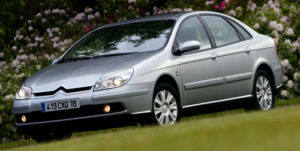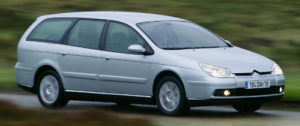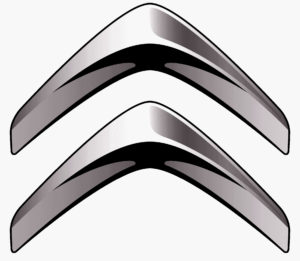2001 the C5 is launched
The C5 focussed heavily on the amount of technology packed into the car – a long-term Citroën trait, but this time it was all computer controlled.
Replacing both the Xantia and XM, the C5 was a hatchback that looked like a saloon, the direct opposite of the GS & CX, saloons that looked like hatchbacks.
 The C5 was the first use of PSA’s ‘platform 3’ architecture, later seen under the 406 & 407 as well as the C6 and the 3008/5008 people carriers, and used a new development of the faithful hydraulic suspension to automatically raise and lower ride height according to road conditions. Hydractive 3 was also the only hydractive-badged system not to include variable stiffness suspension – for that, you needed to buy an upper-spec C5 with H3+.
The C5 was the first use of PSA’s ‘platform 3’ architecture, later seen under the 406 & 407 as well as the C6 and the 3008/5008 people carriers, and used a new development of the faithful hydraulic suspension to automatically raise and lower ride height according to road conditions. Hydractive 3 was also the only hydractive-badged system not to include variable stiffness suspension – for that, you needed to buy an upper-spec C5 with H3+.
However, the introduction of ever more numerous and complicated safety aids (EBA, ESP etc) meant that development of specific systems to work with Citroën’s unique high-pressure hydraulic braking was no longer viable, so the brakes and steering were decoupled from the hydraulic system – now only providing suspension. The engine-driven hydraulic pump was also replaced with an electrically-powered pump, bringing with it the advantage of pressurisation as soon as the car was unlocked, rather than waiting for the engine to be started. The familiar green LHM fluid was also replaced, by an orange fluid dubbed LDS, and spheres changed shape to a flatter, wider ‘mushroom’.
In the place of the old XU family engines, there were the Ford joint venture HDi diesel DW family, which had started to be seen in the last years of the Xantia, joined by petrol developments of them – the EW family – including an HPi version, using Mitsubishi’s GDi lean-burn injection technology. A V6 petrol, using the 24v seen in late XMs and Xantias, sold in small numbers, with the later 1.6 diesel proving more popular.
For 2004, the C5 received a facelift incorporating new nose and (on the hatch) tail lights. It then continued effectively unchanged until being replaced in 2008.


